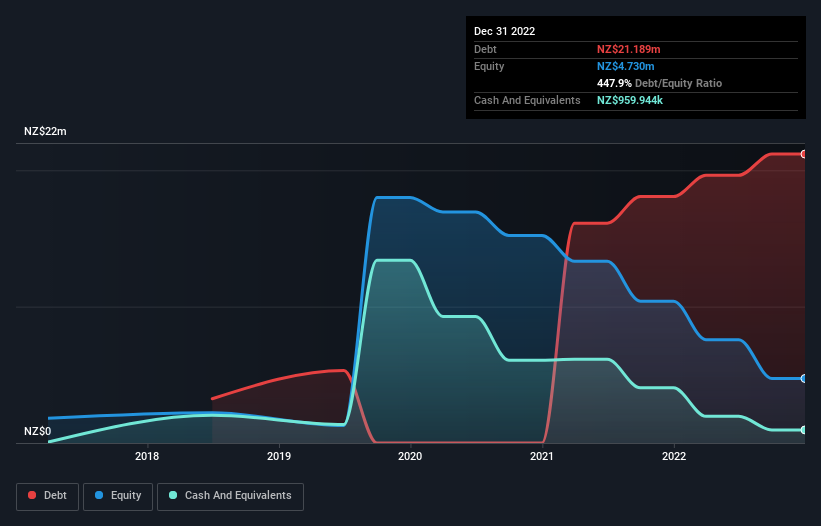
Warren Buffett famously said, 'Volatility is far from synonymous with risk.' When we think about how risky a company is, we always like to look at its use of debt, since debt overload can lead to ruin. We can see that Happy Valley Nutrition Limited (ASX:HVM) does use debt in its business. But the more important question is: how much risk is that debt creating?
Why Does Debt Bring Risk?
Debt and other liabilities become risky for a business when it cannot easily fulfill those obligations, either with free cash flow or by raising capital at an attractive price. If things get really bad, the lenders can take control of the business. However, a more usual (but still expensive) situation is where a company must dilute shareholders at a cheap share price simply to get debt under control. By replacing dilution, though, debt can be an extremely good tool for businesses that need capital to invest in growth at high rates of return. The first thing to do when considering how much debt a business uses is to look at its cash and debt together.
See our latest analysis for Happy Valley Nutrition
What Is Happy Valley Nutrition's Debt?
The image below, which you can click on for greater detail, shows that at December 2022 Happy Valley Nutrition had debt of NZ$21.2m, up from NZ$18.1m in one year. However, it does have NZ$959.9k in cash offsetting this, leading to net debt of about NZ$20.2m.

How Healthy Is Happy Valley Nutrition's Balance Sheet?
We can see from the most recent balance sheet that Happy Valley Nutrition had liabilities of NZ$10.7m falling due within a year, and liabilities of NZ$10.7m due beyond that. On the other hand, it had cash of NZ$959.9k and NZ$39.2k worth of receivables due within a year. So it has liabilities totalling NZ$20.4m more than its cash and near-term receivables, combined.
The deficiency here weighs heavily on the NZ$9.74m company itself, as if a child were struggling under the weight of an enormous back-pack full of books, his sports gear, and a trumpet. So we definitely think shareholders need to watch this one closely. After all, Happy Valley Nutrition would likely require a major re-capitalisation if it had to pay its creditors today. The balance sheet is clearly the area to focus on when you are analysing debt. But you can't view debt in total isolation; since Happy Valley Nutrition will need earnings to service that debt. So if you're keen to discover more about its earnings, it might be worth checking out this graph of its long term earnings trend.
Given it has no significant operating revenue at the moment, shareholders will be hoping Happy Valley Nutrition can make progress and gain better traction for the business, before it runs low on cash.
Caveat Emptor
Importantly, Happy Valley Nutrition had an earnings before interest and tax (EBIT) loss over the last year. Its EBIT loss was a whopping NZ$2.8m. When we look at that alongside the significant liabilities, we're not particularly confident about the company. We'd want to see some strong near-term improvements before getting too interested in the stock. Not least because it had negative free cash flow of NZ$2.8m over the last twelve months. So suffice it to say we consider the stock to be risky. There's no doubt that we learn most about debt from the balance sheet. But ultimately, every company can contain risks that exist outside of the balance sheet. For instance, we've identified 5 warning signs for Happy Valley Nutrition (4 are significant) you should be aware of.
At the end of the day, it's often better to focus on companies that are free from net debt. You can access our special list of such companies (all with a track record of profit growth). It's free.
If you're looking to trade Happy Valley Nutrition, open an account with the lowest-cost platform trusted by professionals, Interactive Brokers.
With clients in over 200 countries and territories, and access to 160 markets, IBKR lets you trade stocks, options, futures, forex, bonds and funds from a single integrated account.
Enjoy no hidden fees, no account minimums, and FX conversion rates as low as 0.03%, far better than what most brokers offer.
Sponsored ContentValuation is complex, but we're here to simplify it.
Discover if Happy Valley Nutrition might be undervalued or overvalued with our detailed analysis, featuring fair value estimates, potential risks, dividends, insider trades, and its financial condition.
Access Free AnalysisHave feedback on this article? Concerned about the content? Get in touch with us directly. Alternatively, email editorial-team (at) simplywallst.com.
This article by Simply Wall St is general in nature. We provide commentary based on historical data and analyst forecasts only using an unbiased methodology and our articles are not intended to be financial advice. It does not constitute a recommendation to buy or sell any stock, and does not take account of your objectives, or your financial situation. We aim to bring you long-term focused analysis driven by fundamental data. Note that our analysis may not factor in the latest price-sensitive company announcements or qualitative material. Simply Wall St has no position in any stocks mentioned.
About ASX:HVM
Happy Valley Nutrition
Happy Valley Nutrition Limited engages in the production and sale of infant milk formula and other nutritional products in New Zealand and internationally.
Medium and slightly overvalued.
Market Insights
Community Narratives



